One of the effects of globalization is the birth of a new international social class that we could call, in turn, the ‘new billionaires’, the ‘hyper-rich’, or, even better, the ‘Über-rich’. This new category, bolstered by financial deregulation and nourished by golden parachutes and the price of oil, is not—and by far—limited to the OECD countries. It has blossomed extravagantly in the ‘emerging’ BRIC nations of Brazil, Russia, India, and China, to give only a few of the more striking examples.
This new global class has something in common—its limitless appetite for the exceptional, the uncommon, and the outrageous. It is not surprising then, that watchmaking, as a producer of precious objects that have always been among the preferred ‘toys’ of the rich and powerful, has gradually followed this trend.
In fact, the watch industry has been well pos-itioned to succeed in this sector since its most prestigious branch—mechanical timekeeping—has enjoyed an unprecedented rise in popularity for a technology that, in and of itself, is actually surpassed by electronic timekeeping. Thus, the mechanical watch has passed from the status of a utilitarian object to the more enviable position of a social symbol. And, in the domain of symbols, the ‘Über-rich’ definitely want to get their money’s worth. In other words, the crazier, the rarer, or the more extravagant something is, the better it is.
This craving for the exceptional has directly favoured the incredible increase in size, which, today, affects all segments of the watch industry. The greater the surface area of a piece, the easier it is to add complications and unusual displays.
Among those who started the oversized trend a few years ago, the North American rappers hold an important place. At the time, they were made fun of for their immoderate taste for wearing the greatest amount of bling bling possible. Their critics, however, displayed a very high degree of short sightedness when they attacked the bling trend because, only a few short years later, even the ‘developed’ segment of timekeeping was giving in to this craze. These timely ‘follies’ became the fashion statement of the day.
The example of HD 3
For the most part, these timepieces were the products of independent watchmakers or small companies which had decided to work in the niche segment of ‘Über-watches’. This was relatively easy for them since, starting from scratch, they had nothing to fear. They also had no difficulty in breaking a number of watchmaking taboos that the large brands were hesitant to defy. The combination of synthesis imagery—that allows for the creation of the most spectacular forms—and new digital manufacturing technology greatly facilitated their task.
“In earlier times,” explains ValÉrie Ursenbacher, of the watch design group HD3 Complication (that she shares with Jorg Hysek and Fabrice Gonet), “we had to make a prototype, and then measure everything with sensors in order to try to more or less reproduce the desired form by machine. Obviously, we were very limited. Today, we can pass directly from my computer, on which I design in three dimensions, to the digital command equipment, on which we will make the piece. Everything has become possible.”
The adventure of the three musketeers of HD3 Complication is also perfectly exemplary of the trend towards the ‘Über-watch’. By training, all three are designers—not watchmakers—and have worked together for nearly 15 years under the leadership of Jorg Hysek, before they all took their common liberty following Jorg Hysek’s decision to sell his former company. Currently working in a small building nestled in the middle of a field of vineyards between Geneva and Lausanne, they decided, “to have fun,” as Jorg Hysek says, “especially since the dominant trend is to make really special pieces.”
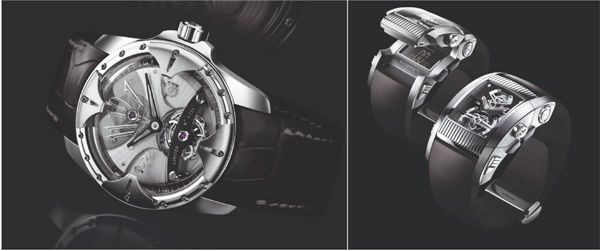
CAPTURE by HD3, RAPTOR by HD3
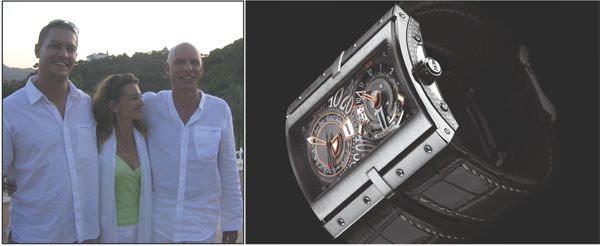
HD3 Group, IDALGO XT-2 by HD3
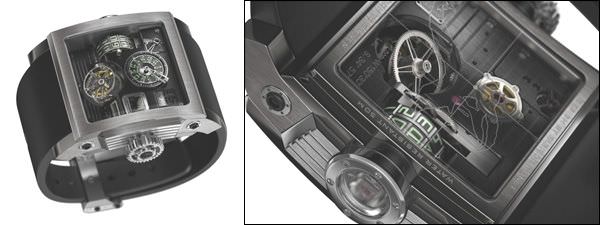
BI-AXIAL TOURBILLON by HD3
For this trio of laid-back designers, everything would happen in an incredible manner. “Just think,” explains Jorg Hysek, “that in October 2003, we gave a book to a Russian retailer, in which we had written down our creative ideas. It contained nothing but drawings on paper, yet we received an order worth 6 million Swiss francs, and an advance to begin production.”
In 2004, production began on the first two watches, Capture, designed by ValÉrie Ursenbacher, and Raptor, created by Fabrice Gonet. They were composed of two La Joux Perret tourbillons placed into cases with a striking design and futuristic decoration. Although they were conceptualized outside of the box, so to speak, they were finished with the utmost in watchmaking care. The Raptor is the most extraordinary, and the piece that best hides its secrets. When opening its double case, we find a tourbillon, under which appears a second movement—a quartz chronograph with a digital display, showing a date and a second time zone. The price of these initial ‘toys’ is around 180,000 Swiss francs for the Capture and 230,000 Swiss francs for the Raptor. Certainly not bad for a few ‘beginners’.
The company’s adventure continued in 2006 with the arrival of the Idalgo XT-2 designed by Jorg Hysek. With the creation of this veritable ‘monster’ (it measures 65mm by 52mm, with a total thickness of 15mm), HD3 Complication took another step by going “further than the customization of an existing movement by creating a veritable movement in the service of a new type of display.” A designer’s approach, certainly, but this watch closely allied its construction with its aesthetics. The features of the piece include a single movement that drives a double dial with, on one side, a jumping hour in a window, a retrograde minute, and seconds hand, while on the other side, a large date in a window, a second time zone, and the oscillating weight. The whole project was made possible because of a collaboration with BNB, the constructor of the movement. The involvement of the movement supplier, BNB, did not happen merely by chance. While the move away from traditional forms and displays is principally seen in the work of independent designers, this new type of watchmaking has been made possible because of the collaboration of young design studios and movement makers who also wanted to leave the traditional approaches behind and come up with something totally new and original. In this respect, a company such as BNB Concept SA (which we will discuss in more detail in an upcoming issue) is particularly emblematic of the availability of new technical ‘resources’, without which, this ‘new’ watchmaking—born away from the large groups—would never have seen the light of day. The verticalization of the large groups, made possible by in-house units as well as by the acquisition of external entities, has gradually been counter-balanced by the renaissance of a whole fabric of small, and often very advanced, suppliers.
Another important point is that a small entity such as HD3 Complication allows for flexibility in product development that is missing in some larger structures that can be unwieldy. This also obviously allows for heightened reactivity. “We make absolutely all the rest in-house,” insists Jorg Hysek. Communications, public relations, catalogues, displays, packaging, and the brand’s website are all directly controlled by the designers.
When they are not working on a watch, they go into the workshop next door, grab a paintbrush, and interpret their creations on a large canvas. It is also a type of creative release that allows them to conceptualize a watch such as the Biaxial, the latest creation from Fabrice Gonet. This piece is a spectacular bi-axial tourbillon developed by BNB, which shows the hour using numbers on two tri-dimensional rollers. The 11 projected watches have all already been sold.
MB&F, a collective adventure
While Jorg Hysek affirms his unbridled admir-ation for Greubel Forsey, “the grand masters,” whose quality of work and watchmaking spirit he greatly respects, he defines himself as, above all, a designer, yet he also recognizes that he has a special ability “to bring together talented watchmakers.” This same facility for uniting talented individuals is also seen in another individual, Max BÜsser, who created MB&F, an acronym for Max BÜsser & Friends.
A long-time General Director of Harry Winston Timepieces, which he succeeded in moving full force into the realm of haute horlogerie, Max BÜsser has been attracted by the potential of the ‘Über-watch’. It is probably his experience with the very adventuresome collection of Opus timepieces that led him in this direction. There is no denying that the concept of the Opus was extremely innovative. The carte blanche, or nearly so, that was given to the very fiercely independent watch designers (among others, Antoine Preziuso, Vianney Halter, FranÇois-Paul Journe, and FÉlix Baumgartner) to create ‘over the top’ timepieces, made an impression on everyone. Not only did the Opus become the favourite talking piece at the watch trade shows but it also demonstrated that there is a real public appreciation for exceptional timepieces.
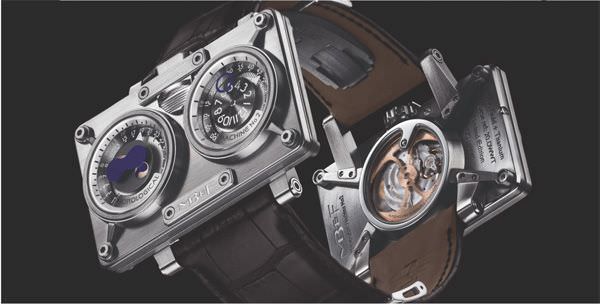
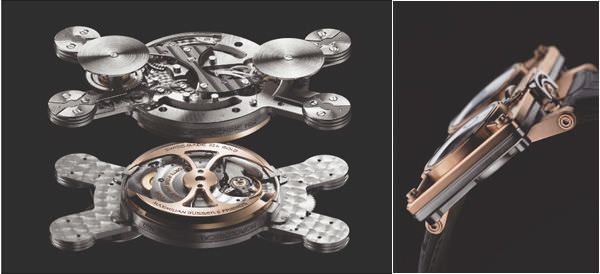
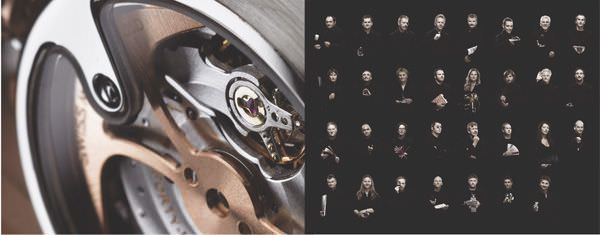
HOROLOGICAL MACHINE by Max BÜsser & Friends
A master strategist, Max BÜsser, after having left Harry Winston, patiently created and encouraged a certain buzz around what he was about to present. His first stroke of genius was the name given to his watches—a name that evoked mystery and would surely attract the young boys in short pants who remained collectors in their soul—Horological Machine. This appellation also implied, in a certain manner, that the piece was more than a simple ‘watch’ but would be, in the words of Max BÜsser himself, “a high-tech machine of the 21st century” but yet a timekeeper whose “exceptional quality and hand finishing bore witness to the best of the traditional art of timekeeping savoir faire.”
To arrive at his goal, Max BÜsser began with an idea that he himself qualifies as ‘utopian’—the formation around each new Horological Machine of a veritable ‘collective’ effort dedicated to the creation ‘in very small quantities’ of watches with a radically new design. As he had done with the Opus, for which he always gave credit to the watchmaker who created it (in contrast to most other well-known brands that don’t reveal their external collaborations), BÜsser decided from the beginning to emphasize the truly collective and collaborative nature of the creation of each watch. At MB&F, all the individuals working on a particular project are placed on the same level. (Max BÜsser, the entrepreneur, remains the principal shareholder of his company, with the minority share having recently been acquired by Serge Kriknoff, the former General Director of the component manufacturer, G&F ChÂtelain, which he left to join, in his turn, MB&F’s new adventure.)
BÜsser was able to establish this collective thanks to the solid network he created during his tenure as the head of Harry Winston Timepieces. This collaborative effort comprises not only suppliers but also a very well established commercial network of highly developed retailers. Moreover, it is with the retailers that Max BÜsser really started his adventure. He travelled the world to show them not a prototype but a simple drawing. Most of the resellers followed him, and thus MB&F was able to begin its realization of the Horological Machine No 1. This true ‘machine’, with its immense case in the shape of an inverted ‘8’ that encloses four parallel barrels, offers a seven-day power reserve and has a raised central tourbillon. The ‘wow’ factor is definitely guaranteed.
From there, still teasing his audience with gradual surprises, MB&F moved on to the Horological Machine No 2, which has only recently been revealed in its entirety. Again, the case is massive, but rectangular this time, with two dials, one for instantaneous jumping hours and concentric retrograde minutes, and the other for a retrograde date display around a hemispheric double moon phase. The watch is driven by a Girard-Perregaux automatic movement. As for the HM 1, the care in finishing is extreme, again demonstrating that the brand’s 21st century machines represent a veritable fusion between high-end timekeeping traditions and positive liberation from them. The formula seems to be working—MB&F has announced a turnover of 5 million Swiss francs for 2007, with an order book already full to the tune of 8.5 million francs for 2008.
Jean Dunand, unique pieces
A whole other example of the Über-watch is found in the brand Jean Dunand, (see our Cover Story) whose philosophy is summed up by Thierry Oulevay, CEO and founder along with Christophe Claret, “We don’t make watches for the market but for individuals.” As such, Jean Dunand prides itself on only making ‘unique pieces’ and to offer, in each of its collections, mechanisms that have never been made before.
The first major exploit of Jean Dunand was the creation in 2005 of the Orbital Tourbillon. Designed by Christophe Claret, this tourbillon was, in a certain way, the precursor of a number of ‘tourbillonesque’ follies that followed. Nonetheless, it remains quite exceptional. Its principle: the barrel and the tourbillon (placed opposite each other) are held between two plates supported by pillars that turn on ball bearings. The upper plate thus forms a ro-tational dial equipped with an opening through which the tourbillon is visible. The hour adjustment as well as the winding is not done using a traditional crown but rather is accomplished vertically, through the back of the timepiece. The absence of a crown allows for the placement of two windows in the case that provide a lateral view of the mechanism. One of these openings (placed at 3 o’clock) is equipped with a vertical hand that indicates the power reserve. The uniqueness of each piece lies in the dial, which are each individually carved from a rare or exceptionally original stone, such as fossil anaconda or caviar.
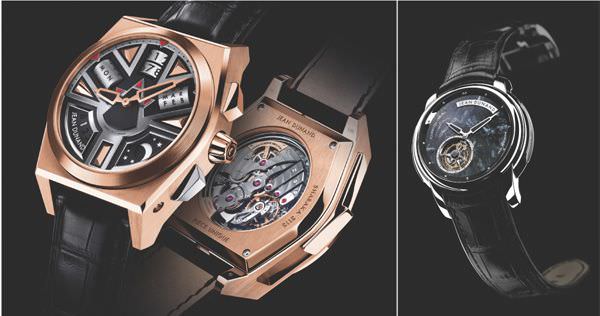
SHABAKA and TOURBILLON ORBITAL by Jean Dunand
Tending towards Art DÉco in design, Jean Dunand watches aspire to create a connection between technical innovation and decorative arts. We find this link in the most recent series of Shabaka watches, which mix inspiration from Art DÉco and Egyptian influences, and display an intriguing dial where hands, numbers, the moon, and small rollers are enigmatically combined.
Technically, Shabaka brings together a number of highly diverse micro-mechanical complexities. It is a minute repeater on a cathedral bell—one of the loveliest watch complications in itself—coupled with a perpetual calendar function whose indications of the date, day, and month are given by four small cylinders. A totally original 90-degree transmission system is required to drive them. On top of that, these indications—adjustable by the two pushbuttons around the crown (the day is changed at 2 o’clock and the other calendar indications at 4 o’clock) and by a coaxial pushbutton integrated into the crown (months and years)—jump instantaneously at midnight.
The leap year indication is also quite original. A small white plate that rotates in four years illuminates the letter B (for bissextile) or the three other years shown by 1, 2, and 3, which are cut out in the dial. The lunar phases (with a theoretical precision of one day every 120 years) are also displayed by the rotation of a disc that either eclipses or reveals the moon. Another subtlety is that the power reserve indication is supplied directly by the barrel spring and is perfectly visible on the back of the timepiece. All these indicators are integrated into a decor with geometric separations constructed on four distinct levels, punctuated by small pyramidal triangles of pink gold.
Obviously, the production of these very exceptional pieces, whose prices vary between 390,000 Swiss francs for the Orbital Tourbillon to 550,000 Swiss francs for the Shabaka, is very limited. Thierry Oulevay envisions that 40 pieces will be created in 2008. Last year, six pieces of another model, a Grande Complication (12 integrated complications), were sold at a price of 700,000 Swiss francs each.
Badollet, a newcomer
The vogue for ‘Über-watches’ continues to attract new players into the field. Recently, a brand announced its arrival into the marketplace—Badollet. The plans of the new brand, according to Aldo Magada, its CEO, are very ambitious. It intends to produce a hundred or so pieces per year at prices that will not be below 200,000 Swiss francs! The company’s investors (collectors and German financiers) have “given it time,” say Magada, “by betting on the long term.”
For the moment, no watch has yet been unveiled but the first collection is set to be introduced in April at BaselWorld 2008. Badollet has announced four different models, equipped with four different movements—a flying tourbillon (in collaboration with BNB) with a meteorite plate, a tourbillon with a chronograph, a minute repeater, and a special timepiece that for the time being goes by the mysterious code name of ‘Bamboo’. Its “design is very particular, and all the elements in its movement, which include aluminium/magnesium bridges, have been economized to the maximum.” That is all the brand is saying for now. In addition to watches, Badollet has announced the creation of “objects linked to time,” such as a “mechanical hourglass” in which the sand will be “replaced by a tourbillon carriage”.
The origin of the name ‘Badollet’ comes from a dynasty of Geneva watchmakers with international connections (members of the Badollet family settled in Paris where they were reputed to have worked with Breguet, in London, and in the United States where one of the Badollet clan formed the city of New Geneva). When asked if this family history is nothing more than a pretext, Aldo Magada defends the choice of name. On the contrary, he affirms, “we draw inspiration from this history, from these watch roots, to project ourselves into the future. The saga of the Badollet family gives us a line of action. They were watchmakers who were interested in the industrialization processes of their time and who distinguished themselves by their continuous technological thought, such as is seen in a small treatise entitled ‘The Excellence of Horology’, published in Geneva in 1689 by a certain Jean Badollet.” (The brand has recently re-published this small work.)
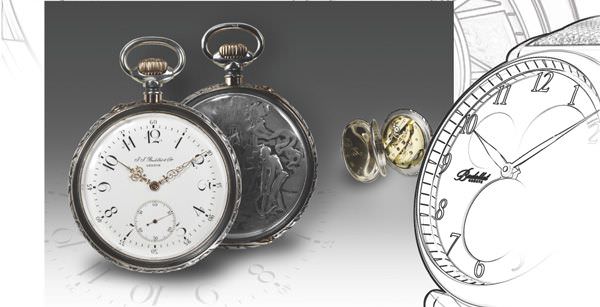
BADOLLET POCKET WATCH by Badollet
This “research into their roots” involves a type of watchmaking that is “far from all the glitz,” declares Magada. Contrary to the ‘spectacular’ timepieces in fashion at the moment, Badollet intends to favour “deep technical reflection and high added value based on the quality of the case and finishing.” To accomplish its goal, the brand has woven a dense web of exclusive subcontractors in Geneva and in the Jurassic Arc region, and has no intention of trying to verticalize production at any cost.
A small technical unity has been established in-house for the design and development of the movement and case. Gradually, the brand expects to master the essential of its cases and its after-sales service. Magada is especially emphatic about the service of the brand’s ‘Über-watches’. Each timepiece will be accompanied by a large palette of services: extensive information for each client who will have his or her own web page for product follow-up; a five-year guarantee; regular servicing including out-of-warranty servicing; pick up and delivery at the client’s home by a representative of the brand; a replacement watch during servicing; and personalized concierge service 24 hours a day.
Badollet is only the latest among those brands determined to invest in the sector of the Über-watch.” We might call it a ‘luxury niche’ but a niche that requires brands to present real advances, whether they are technical or aesthetic, or even in regards to service and distribution. Very importantly, the ‘Über-watch’ phenomenon can also be considered as an advanced development laboratory for the entire watch industry.
Source: Europa Star February-March 2008 Magazine Issue





